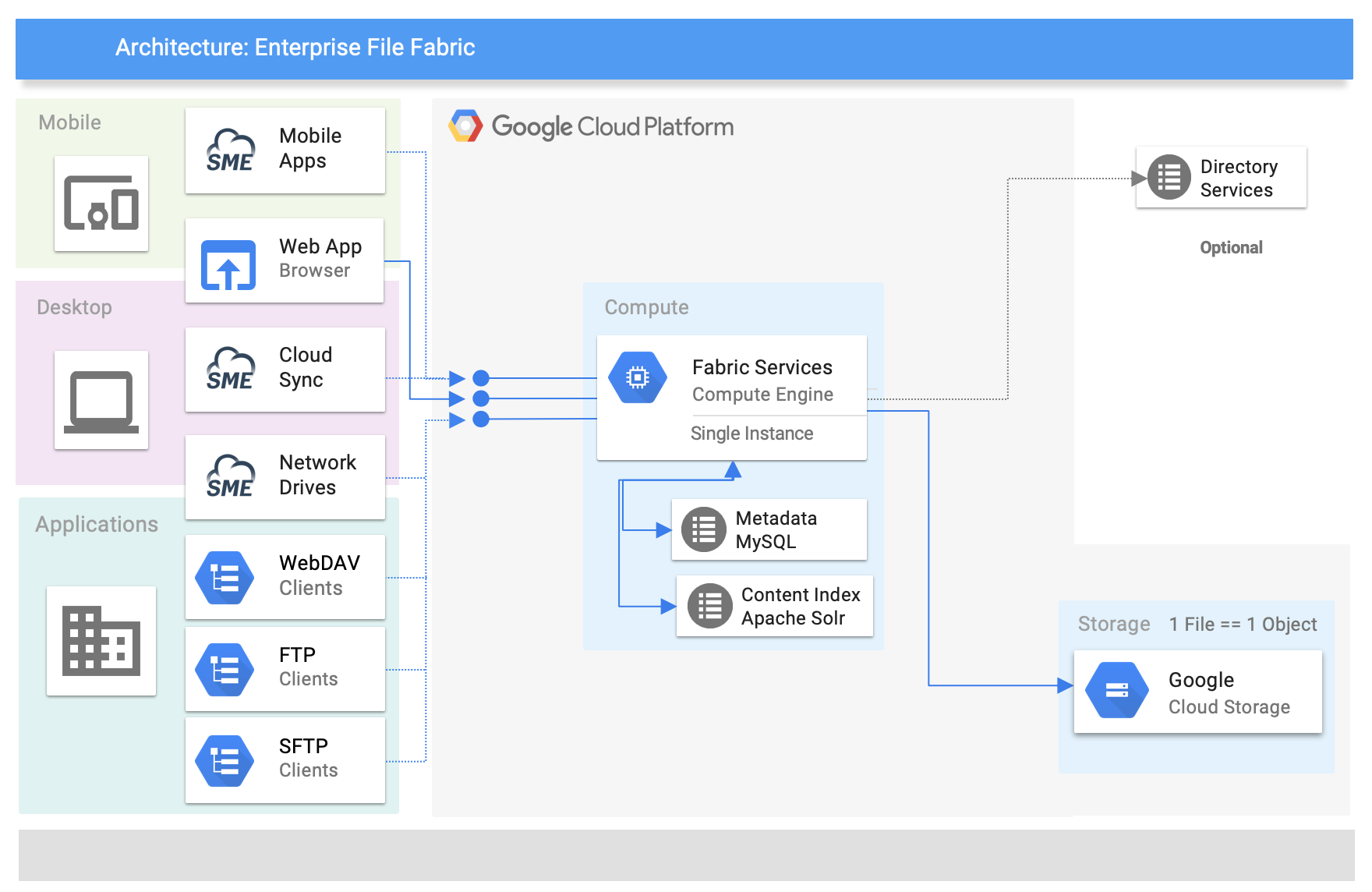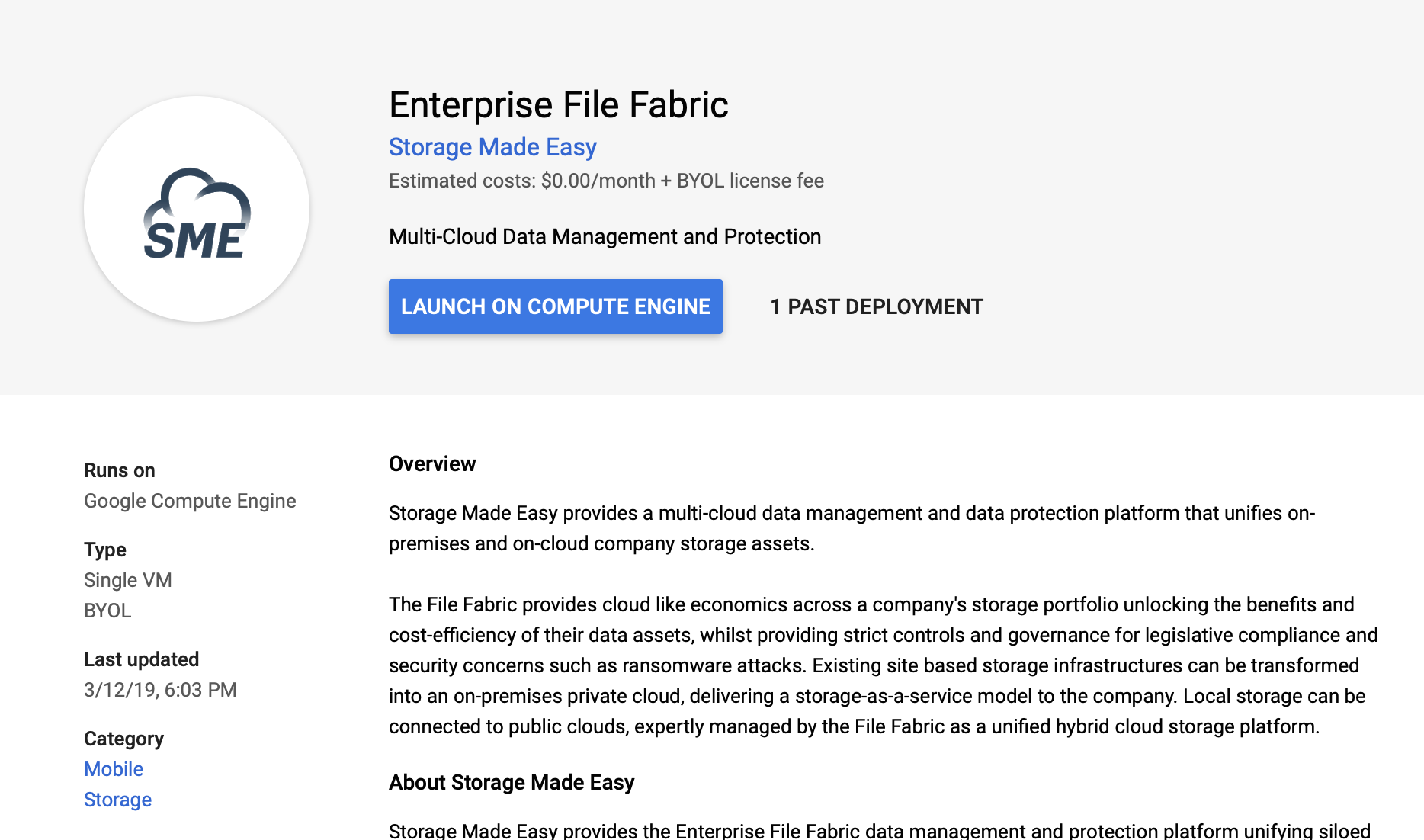Table of Contents
**This is an old revision of the document!**
Getting Started on Google Cloud
Why Google Cloud?
Google Cloud customers are using the File Fabric to take advantage of the high durability, scalability and low cost of Google Cloud Storage. Customers are able to securely extend access to end users and existing file-based applications, significantly reducing migration costs to the cloud.
For more information on See The Enterprise File Fabric™ — The Killer Solution for Object Storage !
Architecture
Single VM Deployment
For evaluation and smaller production environments the Enterprise File Fabric™ solution is typically deployed as a single virtual machine. The virtual machine includes an embedded database and search index.
A single virtual machine can be launched directly from the Google Cloud Platform Marketplace.
Multiple VM Deployment
The Enterprise File Fabric solution may also be deployed for High Availability with multiple virtual machines and a separate database.
Please contact us for more information on setting up HA deployments on the Google Cloud Platform.
For production deployments see also Architecture and Sizing Guide.
Requirements
You will need the following information before you can complete setup on the Google Cloud Platform:
- Access to request / update DNS names for appliance (recommended)
- SME Enterprise File Fabric license key (required) - A trial key can be requested from https://www.storagemadeeasy.com/appform/.
- Outbound mail relay information. (recommended)
- Default storage system connectivity details - Google Cloud Storage recommended (required)
- An Active Directory service account if you are connecting to AD (optional)
Launch
- From the Google Cloud Platform Marketplace click Enterprise File Fabric.
- Then click Launch on Compute Engine.
Deploy
- Choose a name for your instance
- Choose a Zone
- Verify the Machine type - The minimum is large enough for evaluation.
- Set IP Ranges for TCP port 8080 - This port is used only for initial network configuration
- Select Deploy.
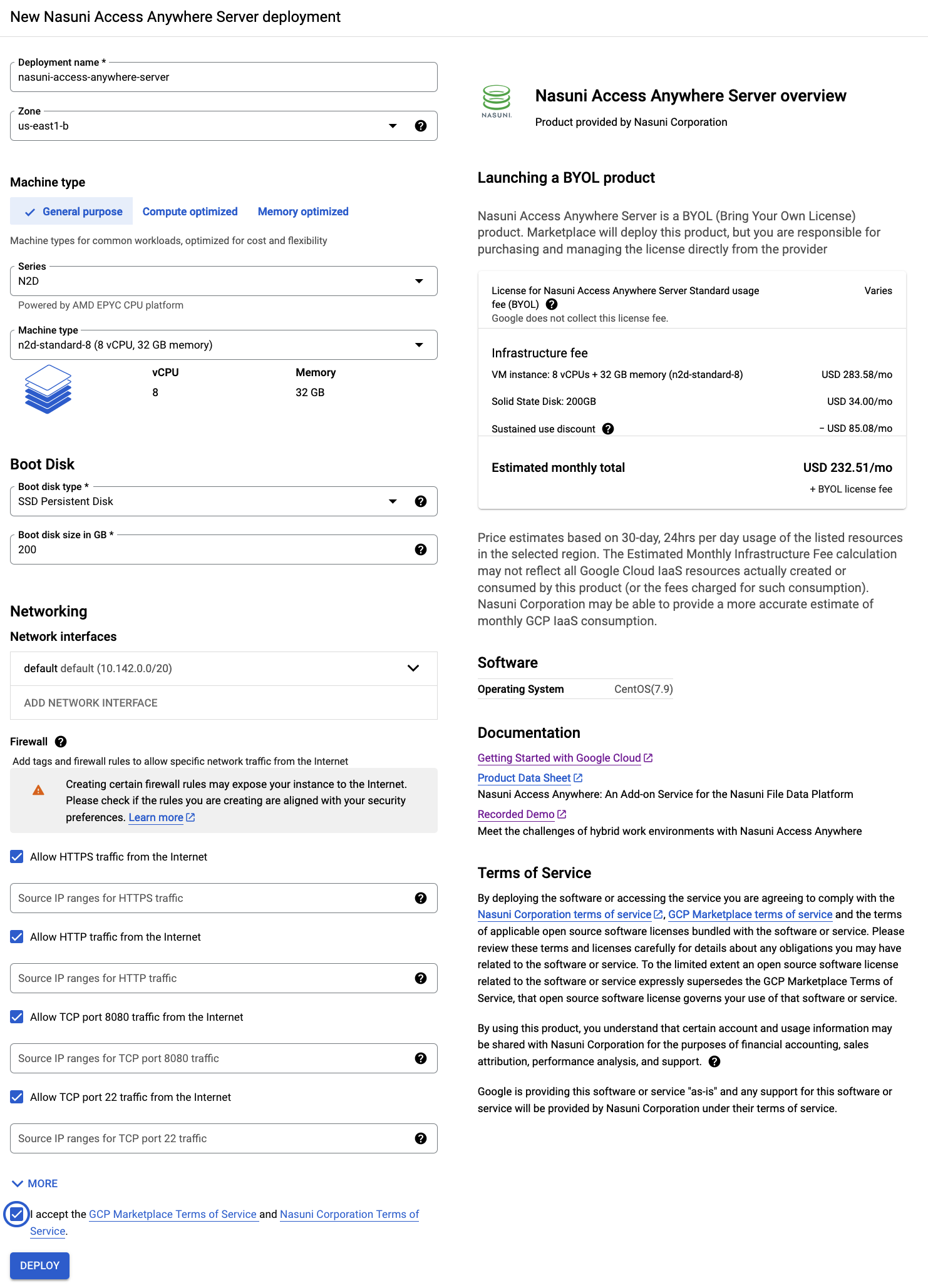
Deployed
After a few minutes an instance is deployed.
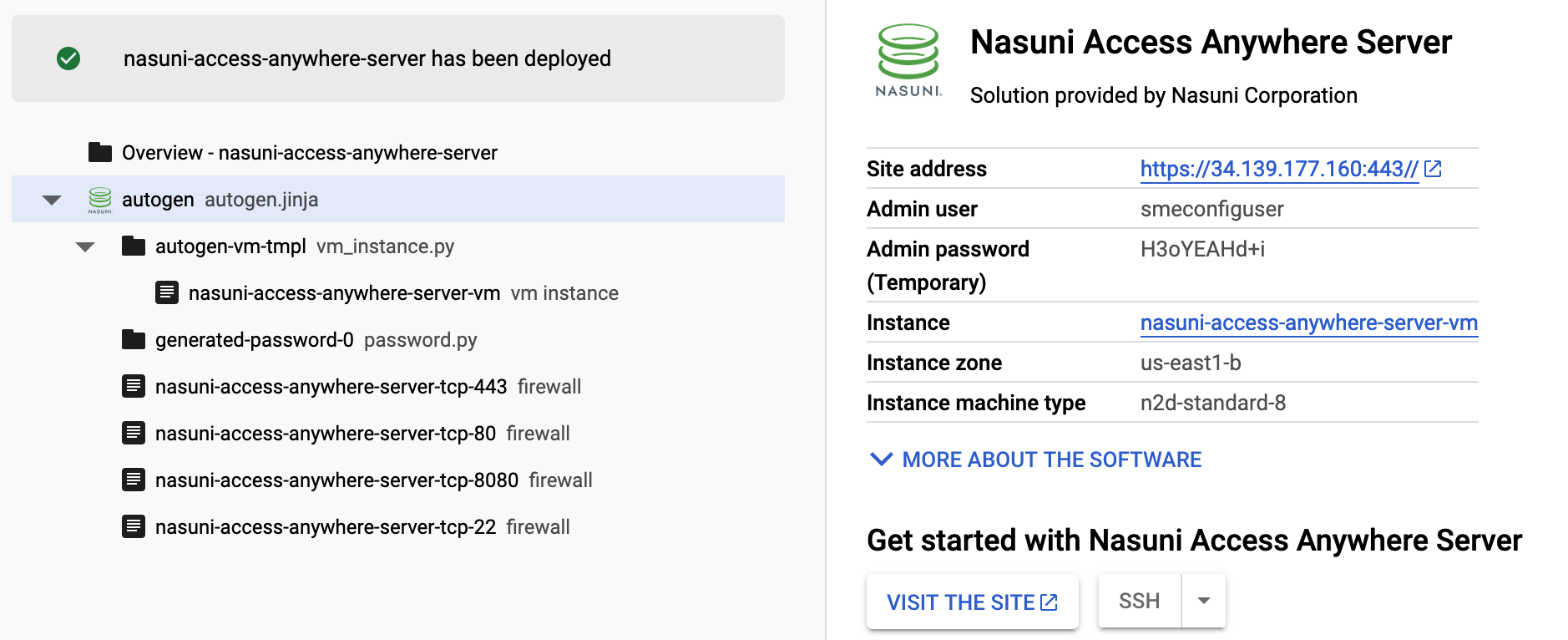
Verify Web Access
From the deployment panel, click the button Visit the site to bring up the appliance login page. You can also use the Site Address URL directly. Use the username appladmin and password Admin password to log into the appliance.
Until changed the appliance has an untrusted SSL certificate. Most browsers will flag this as a potential security issue and require your acknowledgement to bring up the page.
If you don't have the deployment panel, first open the Google Cloud Console. From the top left hamburger menu (aka Navigation menu) go to the page Compute Engine > VM instances. If you don't see the File Fabric instance check the project you are viewing. Open the VM instance details and locate the External IP under Network interfaces. Open the appliance website at https://<External IP>/. The username is appladmin and the password can be found under Customer metadata as the eff_user_password.
Verify SSH Access
From the deployment panel, or from vm instance details, click the SSH button for remote access to the instance (using a browser or another ssh client). Check that you can become the smeconfiguser. (See trial email for password).
su smeconfiguser
Check that you can become root. (See trial email for password).
su -
This will be required to complete configuration.

SSL Configuration (Recommended)
The appliance is configured, by default, with DHCP and a self-generated untrusted SSL certificate.
In order to use the client tools (desktop and mobile applications) over SSL you will need a trusted SSL certificate and a fully qualified domain name (FQDN).
Disabling SSL (Not Recommended)
If you do NOT wish to use SSL for the trial you can disable it:
- Log into the appliance as the Appliance Administrator (appladmin)
- Navigate to Settings > Site Functionality
- Set Always use HTTPS to false.
Create a Static IP Address
Unless you are using a dynamic DNS service you'll need a static IP address in order to create a DNS entry.
From the top menu of the Google Cloud Platform dashboard, navigate to NETWORKING / VPC network > External IP addresses.
The external address of the appliance you just launched is listed as Type Ephemeral. Change it to Static, enter a Name in the dialog box and select RESERVE.

Create DNS entries
Choose three fully qualified domain names (FQDNs). For example:
- files.example.com - Principal name, to be used as hostname
- files-webdav.example.com - used for WebDAV service
- files-s3.example.com - use for S3 service
Add DNS type A records that point these domain names to the appliance IP Address. For example,
| Type | Name | Value |
|---|---|---|
| A | files | 35.188.82.62 |
| A | files-webdav | 35.188.82.62 |
| A | files-s3 | 35.188.82.62 |
Verify that Public DNS records are setup correctly by pinging each FQDN.
ping files.example.com ping files-webdav.example.com ping files-s3.example.com
Change Hostname
To update the appliance with the FQDN change to the root user by issuing “su -“ with SSH. As the root user, edit /etc/hostname with nano or vi.
Change the google instance name to your FQDN.

Start SME Config Server
Leave root privilege and as the smeconfiguser start the configuration server by typing smeconfigserver. You should see a confirmation that the config server is running:

Now open your favorite browser and go to
http://<your_ip>:8080
Configure Hostname Settings
Here you only need to configure the three domain names. Click “Configuration” and then “SME Server Hostname Settings”.
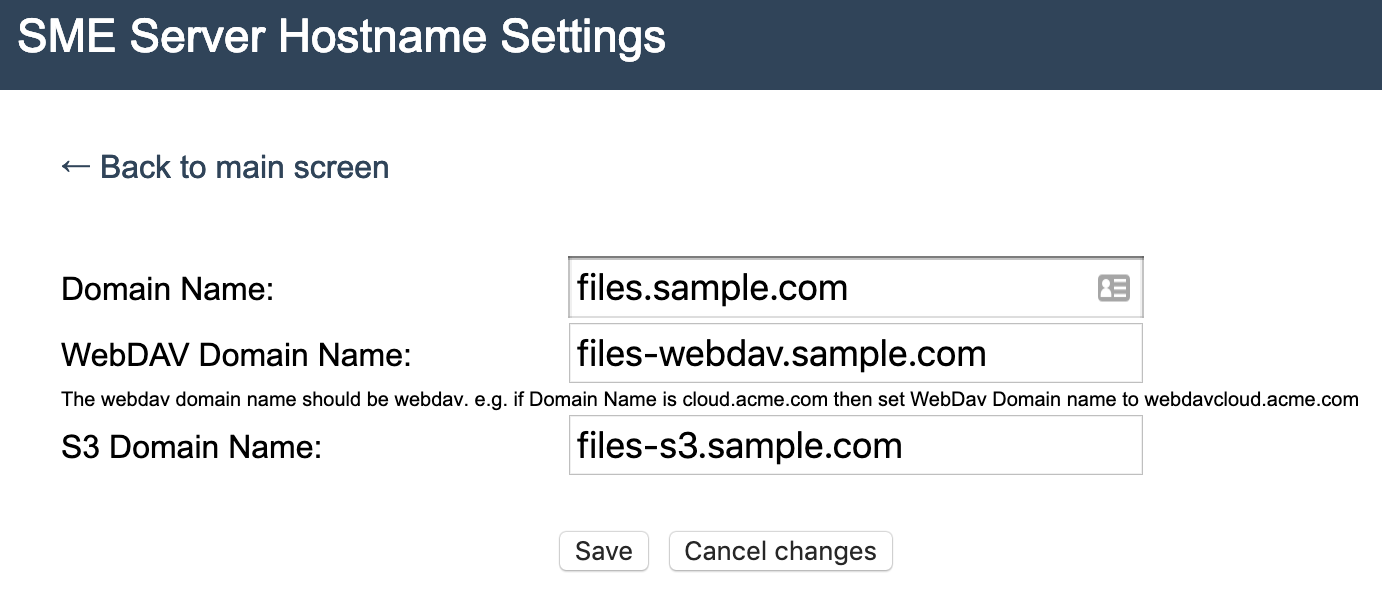
After Saving go to the “Overview” page and scroll down to the bottom to “Apply”. No other changes are required for the appliance on the Google Cloud Platform.
Follow the prompts on the page to reboot the appliance. If you are not doing this immediately stop the Config Server by typing Control-C in the terminal window.
Create SSL Certificates
This section creates and configures SSL certificates from Let's Encrypt. If you are using your own certificates (or a different service) you can use the smeconfigserver above to add certificates.
Elevate to the root user by typing the following command and entering the root password when prompted.
su -
Note: The appliance will be inaccessible during the request which may be up to a minute.
Run the following command:
certbot --authenticator standalone --installer apache --pre-hook "systemctl stop httpd" --post-hook "systemctl start httpd"
This command will prompt for an email address. It’s important to give this information so that an admin can be notified in the future if there are issues automatically renewing the certificate.
Please also agree to the Terms of Service. It is not necessary to share the provided email with the Electronic Frontier Foundation.
Certbot will automatically detect what FQDNs are setup for the Enterprise File Fabric and prompt for which should be included in the certificate.
Which names would you like to activate HTTPS for? - - - - - - - - - - - - - - - - - - - - - - - - - - - - - - - - - - - - - - - - 1: files.example.com 2: files-s3.example.com 3: files-webdav.example.com - - - - - - - - - - - - - - - - - - - - - - - - - - - - - - - - - - - - - - - - Select the appropriate numbers separated by commas and/or spaces, or leave input blank to select all options shown (Enter 'c' to cancel): 1,2,3
Lastly, Certbot will prompt to disable all HTTP access. Please select option 1 as the File Fabric already has HTTP to HTTPS redirection options configured.
Please choose whether or not to redirect HTTP traffic to HTTPS, removing HTTP access. ------------------------------------------------------------------------------- 1: No redirect - Make no further changes to the webserver configuration. 2: Redirect - Make all requests redirect to secure HTTPS access. Choose this for new sites, or if you're confident your site works on HTTPS. You can undo this change by editing your web server's configuration. ------------------------------------------------------------------------------- Select the appropriate number [1-2] then [enter] (press 'c' to cancel): 1
After successful completion, the Enterprise File Fabric will automatically start using the new certificates. These certificates will last for 90 days, so the final step is to setup automated renewal.
Automatically renewing the certificate
A Let’s Encrypt certificate is valid for 90 days, and can be automatically renewed within 30 days of expiration. A simple cron job will run daily and handle renewals.
Please Note: The File Fabric will be inaccessible during the renewal. Please ensure that the renewal time is during off hours. Downtime will only occur every 60 days when a renewal is required and may last up to one minute.
While still logged in as root run the following command to add a cron job.
crontab -e
In the example below the renewal attempt will process at 2:30AM in the timezone of the Enterprise File Fabric. The Enterprise File Fabric ships by default with the timezone set to UTC time. Please adjust this timezone as necessary.
30 2 * * * /bin/certbot renew >> /var/log/letsencrypt/le-renew.log
This will create a crontab entry for a cron job that will handle the renewals and write its output to a log file.
Use https://www.ssllabs.com/ to test the installation.
Outbound Email (Recommended)
An SMTP server is used by the appliance to send registration and notification emails to users. It can be configured under Settings > Email & Filebox.
If you do not configure an email server remember not to use email notification when adding users.
Using Gmail for Outbound Email
Below is a sample what my screen looks like, for an SMTP setup using a Gmail account.

The “Notification Email” address will receive emails from the system warning of license expiration etc. You should enter your email here.
Change Appliance Admin email
With an SMTP server configured you can change the email of the Appliance Admin. Go to the main menu (Hamburger icon) to Password/Login.
Create an Organization
An organization is a tenant within the appliance and is created by the Appliance Administrator.
Log in as the Appliance Admin at https://<yourhostname>/ with a browser. Use the “appladmin” username.
License Key
Configure your license key under Settings > License Key.
A trial key can be requested from https://www.storagemadeeasy.com/appform/.
Review User Package (Optional)
The File Fabric platform uses templates for organizations, in order for us to create our organization, we need to pick a template, before we do, let’s review.
Click “User Packages” and then click the pencil to modify “Organisation Cloud 20 Users” This is a good template to start from. Scroll down to the “Extra options” section and add “Content Search Enabled” and Dropfolders. Use “Crtl-Click“ to add to the selection.
Create Organization
In the hamburger menu, select “Users” and then “Add a User”.
On the Add a User screen create your Organization admin user. (This will also be your organization.)
- User Login: The Organization short name and superuser's username. We recommend the domain name of your company such as “smestorage.com”.
- E-mail: Email address of organizational admin, must be unique to the system, do not use your own.
- Password:
- Name (Company Name): Full organization name.
- Package: The user package template from earlier.
- We do not need to split the license between organizations, leave the last field empty.
Click Save.

Setting Up an Organization
Log out from the Appliance Admin, appladmin user, and log back in as the user you just created.
You will first see the “Add Storage Provider” screen. You have to add storage before you can continue.
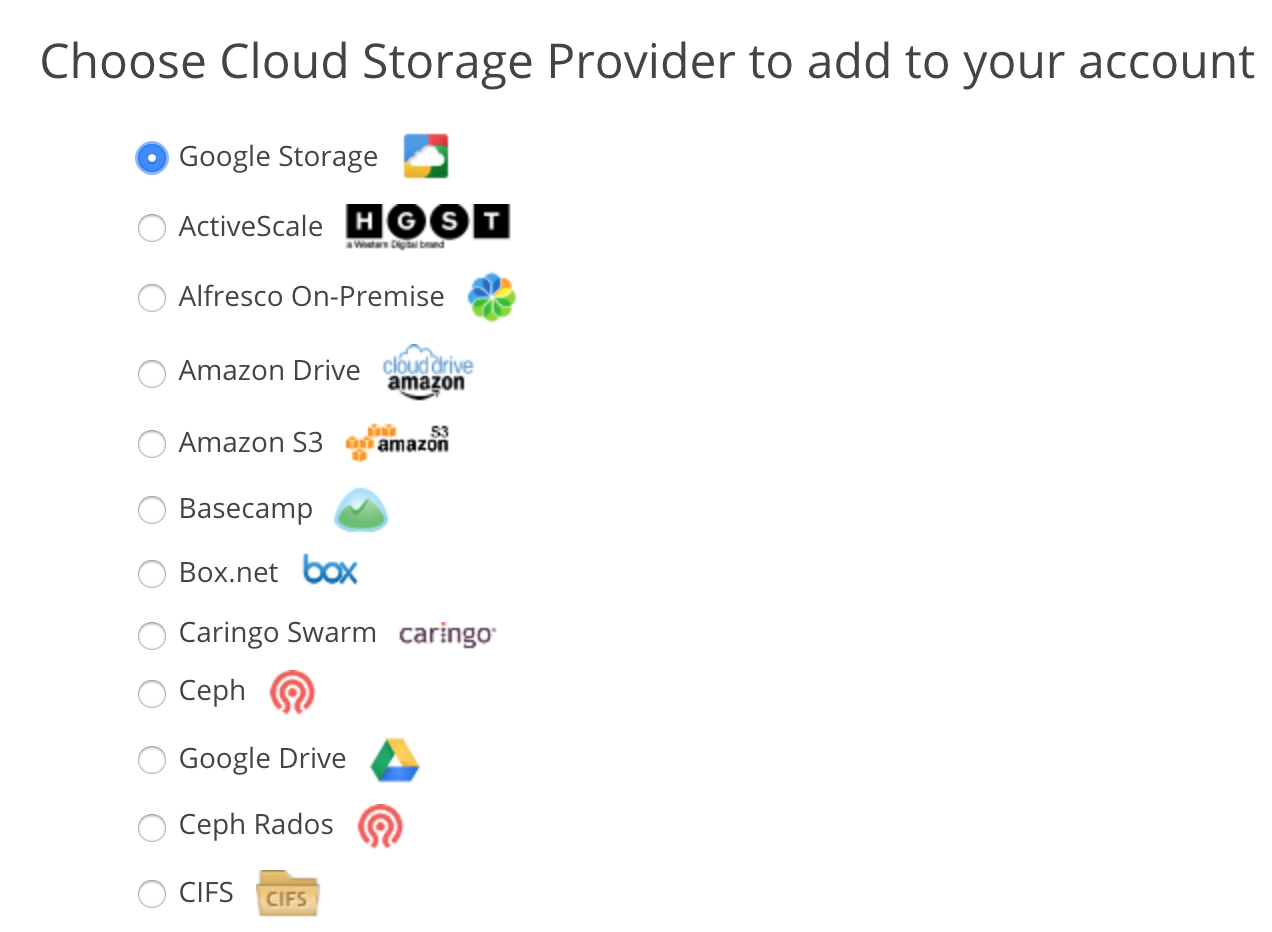
Select your provider and follow the instructions on the next couple of screens. See the next section for information on setting up Google Cloud Storage.
Google Cloud Storage Key
To generate a key for Google Cloud Storage:
- Open the Cloud Storage Settings page in the Google Cloud Platform Console.
- Select “Interoperability”.
- If you have not set up interoperability before, click “Enable interoperability access”.
- Click “Create a new key”.
Do not use a storage location with existing production data for the initial trial.


